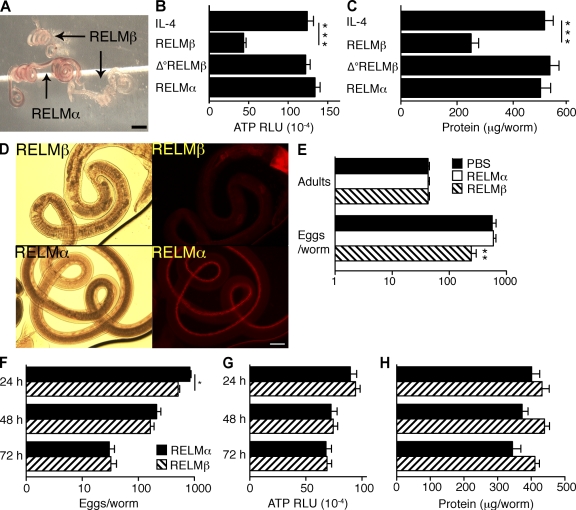Figure 5.
RELM-β impairs feeding and reduces ATP and protein content in H. polygyrus adult worms. (A) Representative photomicrographs of H. polygyrus adults recovered from WT mice 2 d after oral gavage with adult worms pretreated with rRELM-α or rRELM-β. 4× magnification. The experiment was performed four times. Bar, 2 mm. (B) ATP levels of individual adult worms recovered from WT mice 2 d after oral inoculation. Worms were treated with rIL-4, rRELM-β, Δ°rRELM-β, or rRELM-α before inoculation of mice. Data are expressed as relative luminescence units (RLU). Error bars indicate means for 15–17 worms/group. The experiment was performed three times. (C) Protein content of adult worms treated as in Fig. 4 A. (D) H. polygyrus adults were treated with rRELM-α or rRELM-β and inoculated into naive WT. Mice were injected i.v. 2 d later with rhodamine B and worms were recovered from mouse intestines 1 h afterward. 100× magnification. The experiment was performed three times. Bar, 100 µm. (E) Number of viable H. polygyrus adult worms and eggs produced per worm after 16 h in vitro culture in medium supplemented with saline and 1 µg/ml of rRELM-α or rRELM-β. The experiment was performed three times. (F) Fecundity of H. polygyrus adult worms cultured for 24, 48, or 72 h with rRELM-α or rRELM-β. Worms were moved to fresh culture wells every 24 h to allow determination of egg production for each 24-h period. (G) ATP levels of adult H. polygyrus worms cultured for 24, 48, or 72 h with rRELM-α or rRELM-β. (H) Protein content of adult H. polygyrus worms cultured for 24, 48, or 72 h with rRELM-α or rRELM-β. The experiments were performed three times. The error bars indicate the SE of 15–17 worms per group. *, P < 0.05; **, P < 0.01; ***, P < 0.001, compared with IL-4–treated worms.

